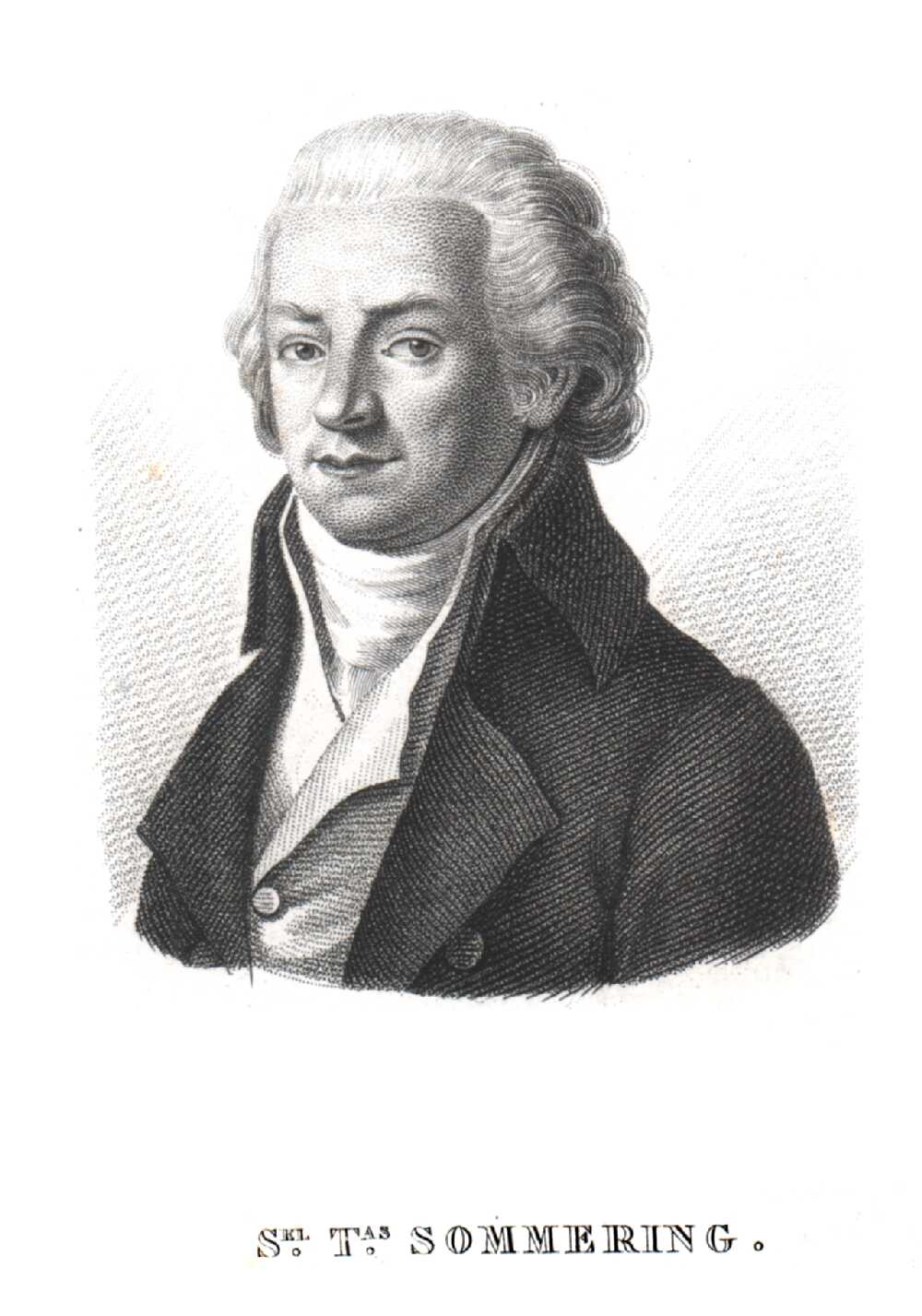- Samuel Thomas von Sömmerring
Infobox Scientist
name = Samuel Thomas von Sömmerring
box_width =
image_width =
caption = Samuel Thomas von Sömmerring
birth_date =January 28 ,1755
birth_place = Thorn (Toruń)
death_date =March 2 ,1830
death_place =
residence =
citizenship =
nationality = flag|Germany|name=German
ethnicity =
field =medicine
work_institutions =
alma_mater =University of Göttingen
doctoral_advisor =Ernst Gottfried Baldinger
doctoral_students =
known_for =
author_abbrev_bot =
author_abbrev_zoo =
influences =
influenced =
prizes =
religion =
footnotes =Samuel Thomas von Sömmerring (
28 January 1755 –2 March 1830 ) was a Germanphysician ,anatomist ,anthropologist ,paleontologist andinventor . Sömmerring discovered themacula in theretina of the humaneye . His investigations on thebrain and thenervous system , on thesensory organ s, on theembryo and its malformations, on the structure of thelung s, etc., made him one of the most important German anatomists.Career
Sömmerring was born in Thorn (Toruń), Polish
Royal Prussia , as the ninth child of the physician Johann Thomas Sömmerring. In 1774 he completed his education in Thorn and began to studymedicine at theUniversity of Göttingen . He visitedPetrus Camper lecturing at the University inFraneker . He became a professor of anatomy at the Collegium Carolinum inKassel and, beginning in 1784, at theUniversity of Mainz . There he was for five years the dean of the medical faculty. In 1795 Sömmerring opened up a practice in Frankfurt. As one of his many important enterprises, Sömmerring introduced against many resistances thevaccination againstsmallpox and became one of the first members of the "Senckenbergische Naturforschende Gesellschaft" and was nominated as counselor. He received offers of employment by theUniversity of Jena and theUniversity of St. Petersburg , but accepted in 1804 an invitation from the Academy of Science of Bavaria, inMunich . In this city, he became counselor to the court and was led into the Bavarian nobility.When Sömmerring was 23 years old he described the organization of the
cranial nerves as part of this doctoral work: its study is valid until today. He published many writings in the fields of medicine, anatomy andneuroanatomy , anthropology, paleontology, astronomy and philosophy. Among other things he wrote about fossilcrocodile s and "Archaeopteryx ". He was also the first to accurately draw a representation of the female skeleton structure.In addition, Sömmerring was a very creative inventor, having designed a
telescope for astronomical observations and anelectrical telegraph in 1809. He worked on the refinement ofwine s,sunspots and many diverse other things. In 1811 he developed the first telegraphic system in Bavaria, which is housed today in the German Museum of Science in Munich.Sömmering was married to Margarethe Elizabeth Grunelius (deceased 1802), and had a son, Dietmar William, and a daughter, Susanne Katharina. Due to bad weather, Sömmering left Munich in 1820 and returned to
Frankfurt , where he died in 1830. He is buried at the city's main cemetery.Works
* "Über die körperliche Verschiedenheit des Mohren vom Europär" (1774)
* "Vom Hirn- und Rückenmark" (Mainz 1788, 2. Aufl. 1792);
* "Vom Bau des menschlichen Körpers" (Frankfurt am Main 1791-96, 6 Bde.; 2. Aufl. 1800; neue Aufl. von Bischoff, Henle u. a., Leipzig 1839-45, 8 Bde.);
* "De corporis humani fabrica" (Frankfurt am Main 1794-1801, 6 Bde.);
* "De morbis vasorum absorbentium corporis humani" (Frankfurt am Main 1795);
* "Tabula sceleti feminini" (Frankfurt am Main 1798);
* "Abbildungen des menschlichen Auges" (Frankfurt am Main 1801),
* "Abbildungen des menschlichen Hörorgans" (Frankfurt am Main 1806),
* "Abbindungen des menschlichen Organs des Geschmacks und der Stimme" (Frankfurt am Main 1806),
* "Abbildungen der menschlichen Organe des Geruchs" (1809).The exchange of letters between Sömmering and
Georg Forster was published by Hettner (Braunschweig, 1878)eben.Bibliography
Wagner, R. "Sömmerings Leben und Verkehr mit Zeitgenossen" (Leipzig 1844).
Wikimedia Foundation. 2010.
